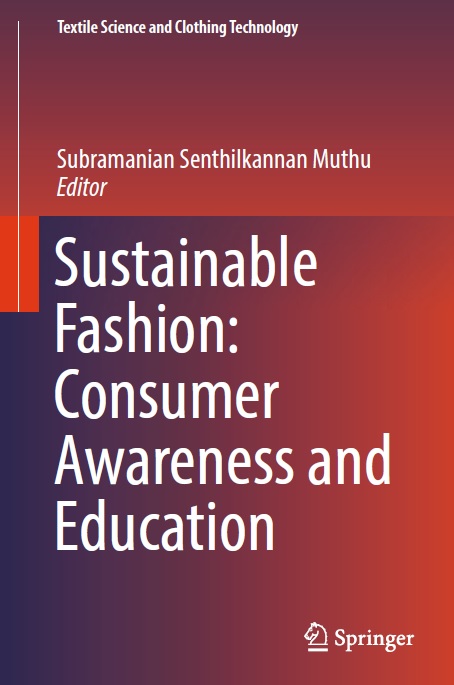by Subramanian Senthilkannan Muthu

Contents
R. Rathinamoorthy
Motives of Sharing: Examining Participation in Fashion Reselling
and Swapping Markets . . . . . . . . . . . . . . . . . . . . . . . . . . . . . . . . . . . . . . 37
Sarah Netter and Esben Rahbek Gjerdrum Pedersen
Fashion as a Matter of Values. On How a Transformative Educating
Process Can Initiate a Positive Change . . . . . . . . . . . . . . . . . . . . . . . . . . 53
Mélanie Sburlino
Consumer’s Awareness on Sustainable Fashion
R. Rathinamoorthy
Abstract The impact of textile and fashion products on the environment is huge and these industries are known as the second most polluting industry in the world, next to oil industries. However, the knowledge about the impact of textile manufacturing methods is still not known to the end users or customers. It also important to note that around 1% of the clothing materials produced only recycled completely towards sustainable production. Researchers also mentioned that, previous studies estimated that more than half of fast fashion items produced was disposed of in under a year.
As themomentum towards the sustainable fashion increased in recent years, the consumer’s knowledge on product is the key for the technologies to sustain. Hence, in this research work, a survey conducted among the individuals in the age group of 20–35, mostly college students and young entrepreneurs and employees from Tamil Nadu, India, to analyse their knowledge on the sustainability concept. From the results of the analysis it is noted that the customers are aware of the environmental implication of apparel manufacturing. However, the customers do not have the moral attitude to engage in a sustainable and ethical purchase. The customers attitude, lifestyle are the major influencing factor over knowledge. In consolidate the sustainable knowledge level observed high but the purchase behavior of the customer not improved significantly as expected due to the external influencing factors.
Keywords Fast fashion · Sustainable fashion · Customer knowledge Preferences · Internal and external factors
1 Introduction
Fashion industry consists of different market sectors. All the different sectors of the industry can be grouped under two category called “haute couture” and “ready-made” sector. The first one is high end fashion materials manufactured for custom fitted measurements and the second on is focused on standardized clothing sizes (Hines and Bruce 2007). Other then these two mentioned category, a sectionwhich falls in the intermediate region of high fashion section and ready to wear category is called as Fast fashion. Fast fashion is a term used to describe clothing collections that are based on themost recent fashion trends.These are generally adaption from current high fashion luxury trend. The main advantage of the fast fashion system is its fast turnaround time that encourages disposability. This is a concept dominated by consumption, fast-changing trends, and low quality; leading consumers buy more clothes because they are affordable but discard these after only one season (Rathinamoorthy 2018).
The fast fashion is one of the major driving forces for the young customer’s selection of apparels. It influencing the customers culture and buying behavior and makes them to purchase more amount of the apparels regardless of their needs. Another one of the important concept which is frequently talked in the industry is “sustainability”. Fast fashion and sustainability are two contradictory concepts often mentioned in the fashion world together. The fast fashion concept in the market had resulted in excessive textile consumption and the disposal of it before their life time (Cao et al. 2014).
As a result the fast fashion concept motivates the manufactures to produce the clothing in amass quantity and encourages the over consumption. Ultimately the fast fashion reaches the market with very less turnaround time; hence, it also motivates the customers to purchase new clothing frequently by disposing the available one at the earliest. This model provides huge opportunities for profit and innovation in the fashion manufacturers. Zara, H&M and Forever 21 are examples of fast fashion stores. These brands are mainly powered by the Internet, globalization and technological innovations (Pal 2016). These stores offers new product after every month or every two weeks instead of old season timing like twice in a year. This fast fashion trend became perfect choice for the shoppers of different income level due to its constant turnover and affordable price range (Siegle 2011) (Fig. 1).
2 Sustainability
The concept of sustainability gained momentum from the Brundtland Report and the Rio Summit. The concept made a significant impact in the society. The sustainable concept has been adapted as a policy goal by many institutions, governments, businesses, and civil society. The fundamental importance for the widespread adoption of the concept is its flexible nature. As a concept, its malleability allows it to be rather open, dynamic, and evolving, and applicable to a variety of situations across space and time. Its openness allows participants at multiple levels and across sectors and institutions to reinterpret it for their particular situation (Kates et al. 2018).
